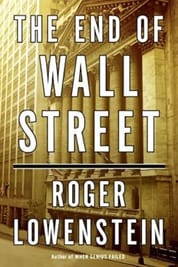The Underpants Gnomes of Wall Street
A review of The End of Wall Street by Roger Lowenstein (New York: Penguin Books, 2010).

In a famous South Park episode we encounter the underpants gnomes, who sneak into people’s homes and steal their underwear. This outlandish behavior follows from their simple business plan: “1: Collect Underpants, 2: ? [sic.], 3: Profit.”
As we gain perspective on the greatest financial crisis since the Great Depression, store shelves abound with books seeking to explain how bankers have morphed from the conservative and prudent gnomes of Swiss legend to the underpants gnomes of South Park.
Roger Lowenstein’s contribution is good, but somewhat disappointing, especially given that his book on the rise and fall of Long Term Capital Management, When Genius Failed, has deservedly become the classic account of that episode of financial folly. He writes too little about the outright fraud committed by financial institutions, and there is nothing on the human suffering from foreclosures, unemployment, or the decimation of communities as increasing numbers of homes are abandoned.
The book has also been rushed to press too early. Many homeowners remain underwater and behind on their mortgage payments, and the housing market is not yet out of the woods. Congress is debating new Wall Street regulations and Goldman Sachs is in trouble for selling crappy securities. And despite what Lowenstein claims, the Great Recession is not officially over. In April, as the book hit stores, the National Bureau of Economic Research said it could not yet call the end of our current recession.
Despite these problems, this book has a lot going for it. Lowenstein tells a good story, and recognizes that people regularly succumb to folly—even the smart people running large financial institutions and government regulatory agencies. He continually stresses that mathematical models in finance are of limited value in a changing world. In his apt description of the problem, we live in a world where the cards in the deck change, while the mathematical models assume that they do not. Lowenstein also provides some much-needed historical perspective by recounting how the government started Fannie Mae in 1938 to help finance mortgages, and then describing the relaxation of standards and ruthless sense of profiteering that motivated financiers to exploit mortgage and mortgage-backed securities.
Lowenstein also explains why the AIG bailout was not part of some Goldman Sachs conspiracy led by ex-Goldman CEO, Treasury Secretary Hank Paulson, as some have suggested. Lowenstein reports that Paulson truly believed that under capitalism, firms should pay for their mistakes and that bailouts create moral hazard problems, but he was unprepared for the scope of the consequences. Lowenstein also gets it right when he stresses that U.S. financial institutions face a capital crisis and not a liquidity crisis. A liquidity crisis occurs when banks don’t have money to lend and ends if banks sell their assets. We face a capital crisis when banks can’t make loans because they lack net worth. This was the case in 2008, when mortgages dropped in value and necessitated TARP and TARP II.
But Lowenstein gets it wrong when he claims that the Great Depression resulted from a liquidity crisis. John Kenneth Galbraith’s classic The Great Crash makes clear that it did not. In the 1920s banks put money into investment trusts that then purchased individual corporate stock. When the stock market crashed in October 1929, banks had insufficient capital, which precipitated bank runs, an end to lending, and the subsequent depression.
Finally, this is a badly titled book. It implies an end to Wall Street’s speculation and liberal lending after the collapse of Lehman Brothers. But there is no evidence that Wall Street or its culture of free markets and speculation is ending. As of this writing, stock prices have bounced back and a good deal of the TARP money has been repaid. As new financial instruments are created and new markets arise, the institutions peddling these instruments will surely extol the virtues of spreading risk and providing more capital to chosen industries.
At the end of the book, invoking economist Hyman Minsky, Lowenstein notes that investors have short memories and are doomed to repeat their mistakes. So it is not really over for Wall Street. With time, the financial underpants gnomes will again rear their ugly heads and do severe damage to the U.S. economy—just as the South Park underpants gnomes killed Kenny under a carload of underpants.
